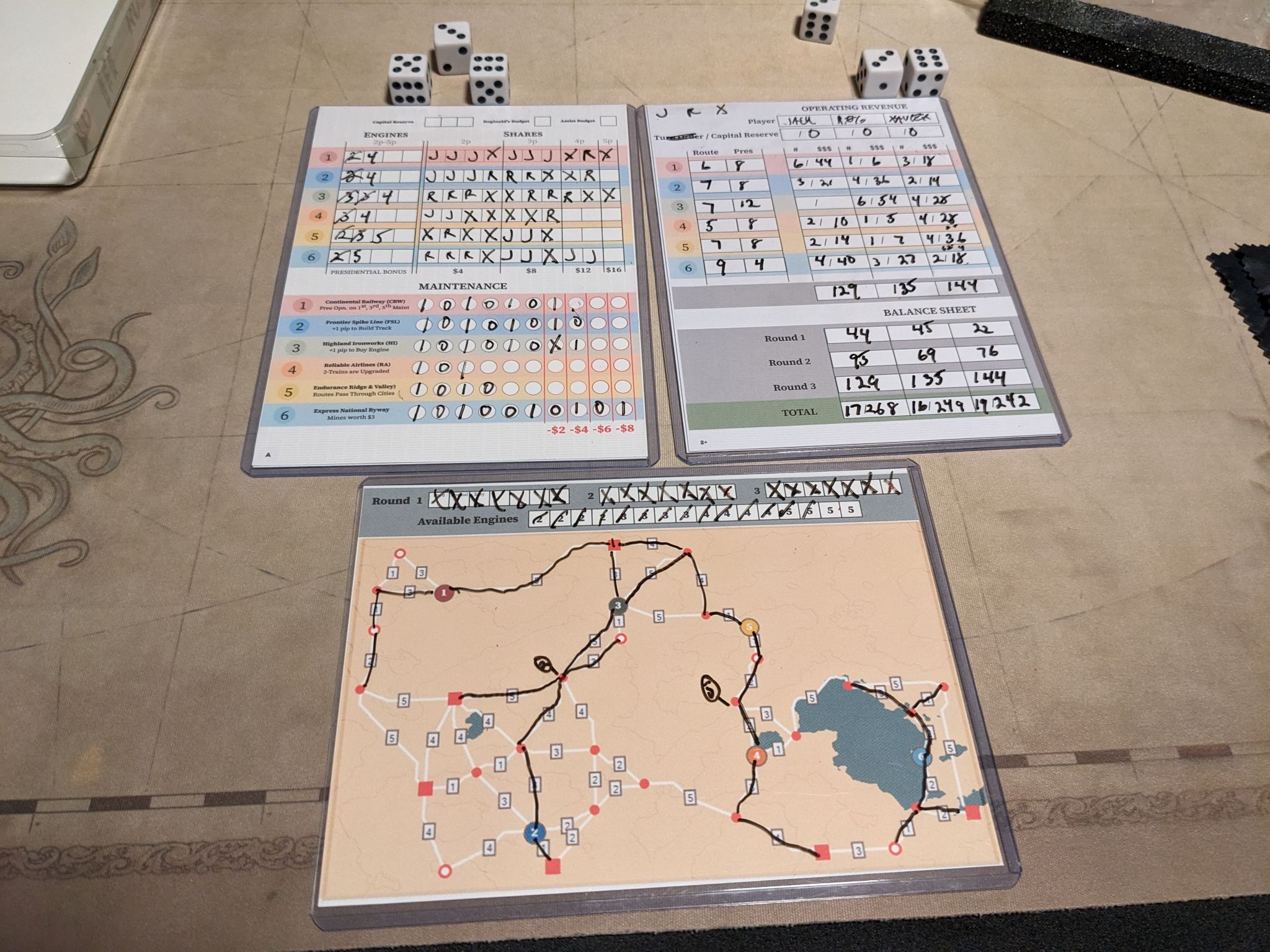Design Diary: From 18XX to 3 Dice and a Sheet of Paper
When I first started working on Rust & Revenue, my goal was to take the essence of an 18XX economic game and compress it into a fast, solo-first roll-and-write format. I wanted a game you could set up in minutes, play in under an hour, and still feel the arc of growth, competition, and decline that defines train games. Roll-and-writes are usually lighter fare; 18XX is a sprawling system.
That meant making some hard choices about what to keep, what to adapt, and what to leave behind. A full 18XX experience relies on sprawling maps, meticulous bookkeeping, and multi-hour sessions where every train and stock certificate has to be tracked. None of that was going to survive the transition. But the feel of 18XX - the way companies rise and fall, the tension of investing, and the sense that every decision has a cost - that was what I wanted to carry over.
Scaling down the economy: The first step was shrinking the numbers. In traditional 18XX, cities can pay out handsomely, shares stack up, and stock values swing. For a compact design, though, big numbers don’t create tension - they just create math. I deliberately kept cities and towns on smaller values so that every pip mattered and payouts felt lean but meaningful.
Service capacity over trains: Another adjustment was abstracting trains. Instead of tracking every piece of rolling stock, I shifted to the idea of “service capacity.” It was cleaner to manage but still forced the same tough choices - do you push to expand, or do you risk falling behind when new, larger capacities come online? It kept the pressure while removing clutter.
Pips as currency: The dice had to matter for more than randomization. Using pips as currency tied the whole system together. A single die roll represented money, tempo, and opportunity. That decision immediately gave the game the kind of tight economy I wanted, where every action feels like a tradeoff. I expanded on this for multiplayer by adding an extra die for turn order. Timing is contested in train games, and I’m pleased with how Rust & Revenue layers that tension into another decision point.
The rhythm of growth and decline: One of the things I love most about 18XX is that companies don’t just climb forever - they stagnate, they rust out, they collapse if you aren’t careful. Preserving that arc in a 30-minute game was important to me. By forcing players into a rhythm of investing and operating, and by letting company value fade over time, Rust & Revenue creates a natural pressure to adapt. You can’t just ride one company to victory.
All track is your track - unless it’s not: In 18XX, track is usually shared. Stations are used by railroad companies to mark and block competitors, with hex tiles upgrading from yellow to green to brown while terrain complicates construction. Rust & Revenue simplifies this by assigning values to lines on the map that are paid out with pips. It’s a roll-and-write, so it’s perfectly fine to draw on the board - though if you tried that in an 18XX game, you’d probably be thrown out.
The table decides:
Train games thrive on multiple players competing over track, shares, and trains. Solo games are usually about facing down one automated opponent. Rust & Revenue takes a different approach by merging two distinct bot styles into something that approximates a small table of rivals. It’s still not the same as your friends whooping over a hostile takeover, but the push and pull of managing your holdings against theirs comes through in spades. I’m proudest of this part of the design. Ironically, it made building the multiplayer version easier, since the upfront work of simulating a table was already done for the bots.
What I learned: All of these choices were deliberate. Together, they form a condensed economic cycle that feels familiar if you know 18XX, but approachable if you don’t. The game has a short span, but inside it you’ll experience growth, opportunity, decline, and the race to adapt. That’s the heart of the genre, and I believe Rust & Revenue stays true to its roots.
(Pictured below is a recent run of the 2-player game modular version of the game. It will be a physical production will feature sliding sheets for player boards and maps. Dice, markers, a cloth will be packaged in a trim clamshell. Release will be done via a separate project here on itch-io later this fall.)
Get Rust and Revenue
Rust and Revenue
Solo homage to 18XX and cube rail games. Compete against two automated rivals using a single-page sheet and four dice
| Status | Released |
| Category | Physical game |
| Author | Jack Neal Games |
| Tags | Board Game, Railroad |
| Languages | English |
More posts
- Next (Demo) Stop, Oswego NY!4 days ago
- Historic Map Pack No. 1: Art, Maps, and Momentum8 days ago
- Historic Map Pack Nearing Completion: Variants and Villainy16 days ago
- Designer Diary: Building Better Bots24 days ago
- Delivery Day31 days ago
- Limited Edition Available Early (Now)32 days ago
- Closing the Loop: Limited Edition, Maps, and Next Steps36 days ago
- Limited Physical Edition Available November 7th39 days ago
- Essexstrand - Weekly Map #543 days ago
- Upcoming Demo at Unplugged Gaming / Photo Drop45 days ago

Leave a comment
Log in with itch.io to leave a comment.